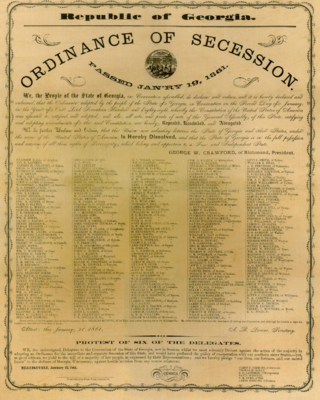Confederate States
Confederate organized
State forces
Territories
- Arizona Territory
- Indian Territory (also known as Oklahoma)
This article includes a military-related list of lists.
This is a list of American Civil War units, consisting of those established as federally organized units as well as units raised by individual states and territories. Many states had soldiers and units fighting for both the United States (Union Army) and the Confederate States (Confederate States Army). The border states had both Confederate and Union units, and in many of the Confederate states Union forces organized Union units from individuals who swore loyalty to the United States.

The territory of the United States and its overseas possessions has evolved over time, from the colonial era to the present day. It includes formally organized territories, proposed and failed states, unrecognized breakaway states, international and interstate purchases, cessions, and land grants, and historical military departments and administrative districts. The last section lists informal regions from American vernacular geography known by popular nicknames and linked by geographical, cultural, or economic similarities, some of which are still in use today.

The Solid South or the Southern bloc was the electoral voting bloc of the states of the Southern United States for issues that were regarded as particularly important to the interests of Democrats in those states. The Southern bloc existed between the end of the Reconstruction era in 1877 and the passage of the Civil Rights Act of 1964. During this period, the Democratic Party overwhelmingly controlled southern state legislatures, and most local, state and federal officeholders in the South were Democrats. During the late 1800s and early 1900s, Southern Democrats disenfranchised blacks in all Southern states, along with a few non-Southern states doing the same as well. This resulted essentially in a one-party system, in which a candidate's victory in Democratic primary elections was tantamount to election to the office itself. White primaries were another means that the Democrats used to consolidate their political power, excluding blacks from voting in primaries.

The Southeastern United States, also referred to as the American Southeast, the Southeast, or the South, is a geographical region of the United States located in the eastern portion of the Southern United States and the southern portion of the Eastern United States. The region includes a core of states that reaches north to Maryland and West Virginia, bordering the Ohio River and Mason–Dixon line, and stretches west to Arkansas and Louisiana.

The 1st Confederate States Congress, consisting of the Confederate States Senate and the Confederate States House of Representatives, convened between February 18, 1862, and February 17, 1864. This assembly took place during the first two years of Jefferson Davis's presidency, convening at the Virginia State Capitol in Richmond, Virginia.

The 2nd Confederate States Congress, consisting of the Confederate States Senate and the Confederate States House of Representatives, met from May 2, 1864, to March 18, 1865, during the last year of Jefferson Davis's presidency, at the Virginia State Capitol in Richmond, Virginia; the Confederacy's government effectively dissolved 16 days later, when it fled Richmond on April 3, 1865. Its members were elected in the 1863 congressional elections.

An Ordinance of Secession was the name given to multiple resolutions drafted and ratified in 1860 and 1861, at or near the beginning of the Civil War, by which each seceding Southern state or territory formally declared secession from the United States of America. South Carolina, Mississippi, Georgia, and Texas also issued separate documents purporting to justify secession.
The Association of Public and Land-grant Universities (APLU) is a research, policy, and advocacy organization of public research universities, land-grant institutions, state university systems, and higher education organizations. It has member campuses in all of the United States as well as the District of Columbia, four U.S. territories, Canada, and Mexico.
The following list is a bibliography of American Civil War Confederate military unit histories and are generally available through inter-library loan. More details on each book are available at WorldCat. For an overall national view, see Bibliography of the American Civil War. For histories of the Union, see Bibliography of American Civil War Union military unit histories. For a guide to web sources see: Carter, Alice E.; Jensen, Richard. The Civil War on the Web: A Guide to the Very Best Sites—Completely Revised and Updated (2003).
On April 15, 1861, at the start of the American Civil War, U.S. President Abraham Lincoln called for a 75,000-man militia to serve for three months following the bombardment and surrender of Fort Sumter. Some southern states refused to send troops against the neighboring Deep South slave states of South Carolina, Mississippi, Florida, Alabama, Georgia, Louisiana, and Texas. The result was that most states in the Upper South of Virginia, Arkansas, North Carolina, and Tennessee also declared secession from the United States and joined the Confederate States.
In general the bibliography of the American Civil War comprises over 60,000 books on the war, with more appearing each month. There is no complete bibliography to the war; the largest guide to books is over 40 years old and lists over 6,000 titles selected by leading scholars. The largest guides to the historiography annotates over a thousand titles.